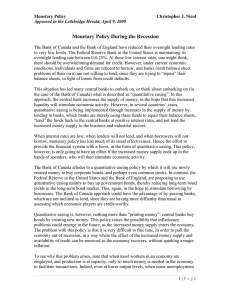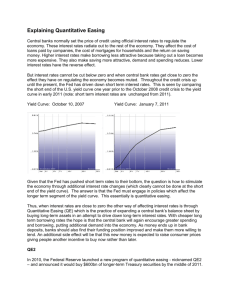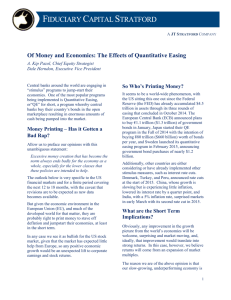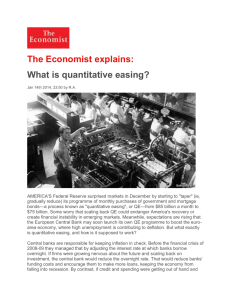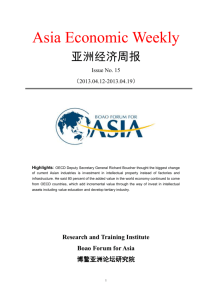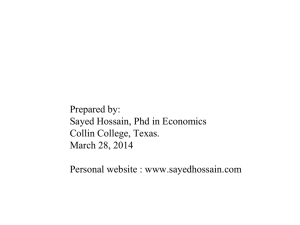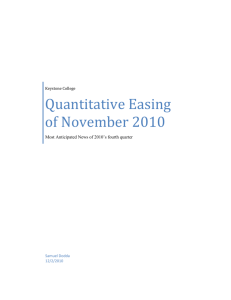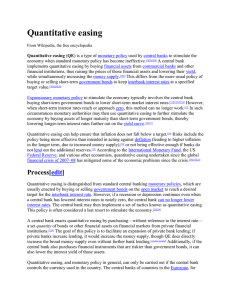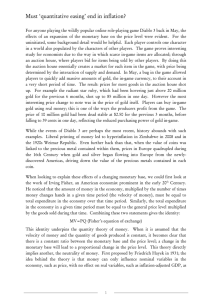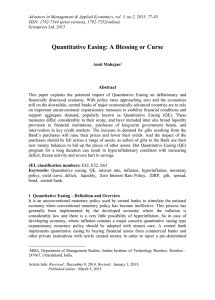Introduction of Quantitative Easing
advertisement
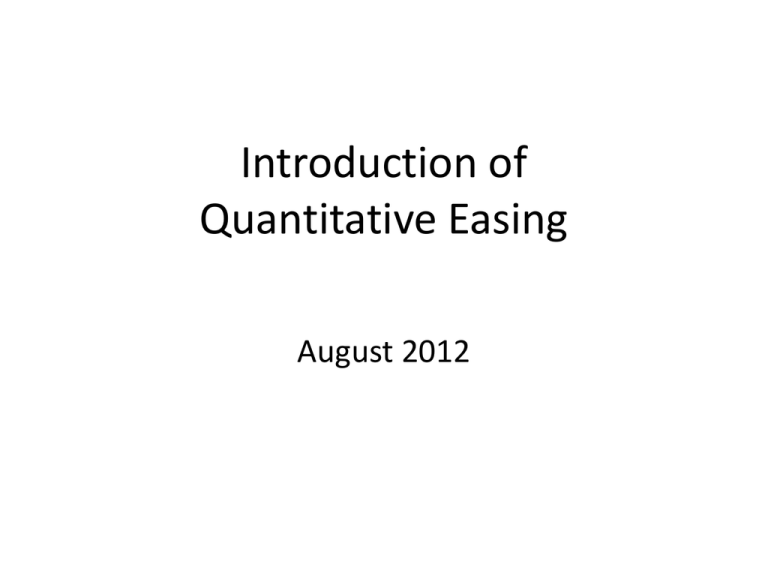
Introduction of Quantitative Easing August 2012 What is Quantitative Easing? • Quantitative easing (QE) is an unconventional monetary policy used by central banks to stimulate the national economy when conventional monetary policy has become ineffective. – When short-term interest rates are either at, or close to, zero, normal monetary policy can no longer lower interest rates. – Quantitative easing maybe used by the monetary authorities to further stimulate the economy by purchasing assets of longer maturity than only short-term government bonds, and thereby raising price but lowering interest rates of the long term securities. What is Quantitative Easing? Cont. • How to implement QE? – A central bank implements quantitative easing by purchasing financial assets from banks and other private sector businesses with new electronically created money. – This action increases the excess reserves of the banks, and also raises the prices of the financial assets bought, which lowers their yield. • With excess reserves, banks can make more loans. – In comparison, conventional monetary policy is by buying or selling government bonds to keep market interest rates at target rate. • Expansionary monetary policy involves the central bank buying short-term government bonds – lower short-term interest rates (via open market operations). Goal of QE • Quantitative easing can be used to help ensure inflation does not fall below target. • Risks include the policy being more effective than intended in acting against deflation – leading to higher inflation, – or of not being effective enough • if banks do not lend out the additional reserves. Conventional Monetary Policy • Conventional Monetary Policy – A central bank conducts monetary policy by raising or lowering its interest rate target for the inter-bank interest rate. – A central bank generally achieves its interest rate target mainly through open market operations, where the central bank buys or sells short-term government bonds from banks and other financial institutions. – When the central bank disburses or collects payment for these bonds, it alters the amount of money in the economy, while simultaneously affecting the price (and thereby the yield) for short-term government bonds. – This in turn affects the interbank interest rates, the federal fund rate Why QE? • If the nominal interest rate is at or very near zero, the central bank cannot lower it further. Such a situation, called a liquidity trap, can occur, for example, during deflation or when inflation is very low. • In such a situation, the central bank may perform quantitative easing by purchasing a pre-determined amount of bonds or other assets from financial institutions without reference to the interest rate. • The goal of this policy is to increase the money supply rather than to decrease the interest rate, which cannot be decreased further. This is often considered a "last resort" to stimulate the economy. Timeline • The US Federal Reserve held between $700 billion and $800 billion of Treasury notes on its balance sheet before the recession. • In late November 2008, the Fed started buying $600 billion in Mortgage-backed securities (MBS). • By March 2009, it held $1.75 trillion of bank debt, MBS, and Treasury notes, and reached a peak of $2.1 trillion in June 2010. • Further purchases were resumed in August 2010 when the Fed decided the economy was not growing robustly. After the halt in June holdings started falling naturally as debt matured and were projected to fall to $1.7 trillion by 2012. Timeline cont. • The Fed's revised goal became to keep holdings at the $2.054 trillion level. • To maintain that level, the Fed bought $30 billion in 2–10 year Treasury notes a month. • In November 2010, the Fed announced a second round of quantitative easing, or "QE2", buying $600 billion of Treasury securities by the end of the second quarter of 2011. Effectiveness Of QE • IMF – QE contributed to the reduction in systemic risks following the bankruptcy of Lehman Brothers. – QE contributed to the improvements in market confidence and the bottoming out of the recession in the G-7 economies in the second half of 2009. • In November 2010, a group of conservative Republican economists and political activists released an open letter to Federal Reserve Chairman Ben Bernanke questioning the efficacy of the Fed's QE program. The Fed responded that their actions reflected the economic environment of high unemployment and low inflation. Effectiveness of QE (cont.) • Increasing the money supply tends to depreciate a country's exchange rates versus other currencies. – Exporters and debtors benefit from QE because of cheaper $ – Importers and creditors are harmed from QE • Banks might invest new money in – emerging markets – commodity-based economies – non-local opportunities – So local businesses still have difficulty getting loans. Risk of QE • Quantitative easing may cause higher inflation than desired if the amount of easing required is overestimated, and too much money is created. • QE can fail if banks remain reluctant to lend money to small business and households in order to spur demand. • In the context of a global economy, lower interest rates may contribute to asset bubbles in other economies. – Cheap to borrow from US. The borrowed can be invested in other countries. Bubble thus is created. Printing Money or Not • QE’s nickname: Printing money • Difference – QE: the newly created money is used for buying government bonds or other financial assets – printing money: newly minted money is used to directly finance government deficits or pay off government debt • Central banks in most developed nations (e.g., UK, US, Japan, and EU) are forbidden by law to buy government debt directly from the government and must instead buy it from the secondary market. • They adopt two-step process – government sells bonds to private entities which the central bank then buys Timeline Timeline Cont. Videos • http://www.youtube.com/watch?v=PTUY16CkS-k Quantitative Easing Explained http://www.youtube.com/watch?v=oGIvw7T0GPI&feature=watch_response Quantitative Easing Re-explained
